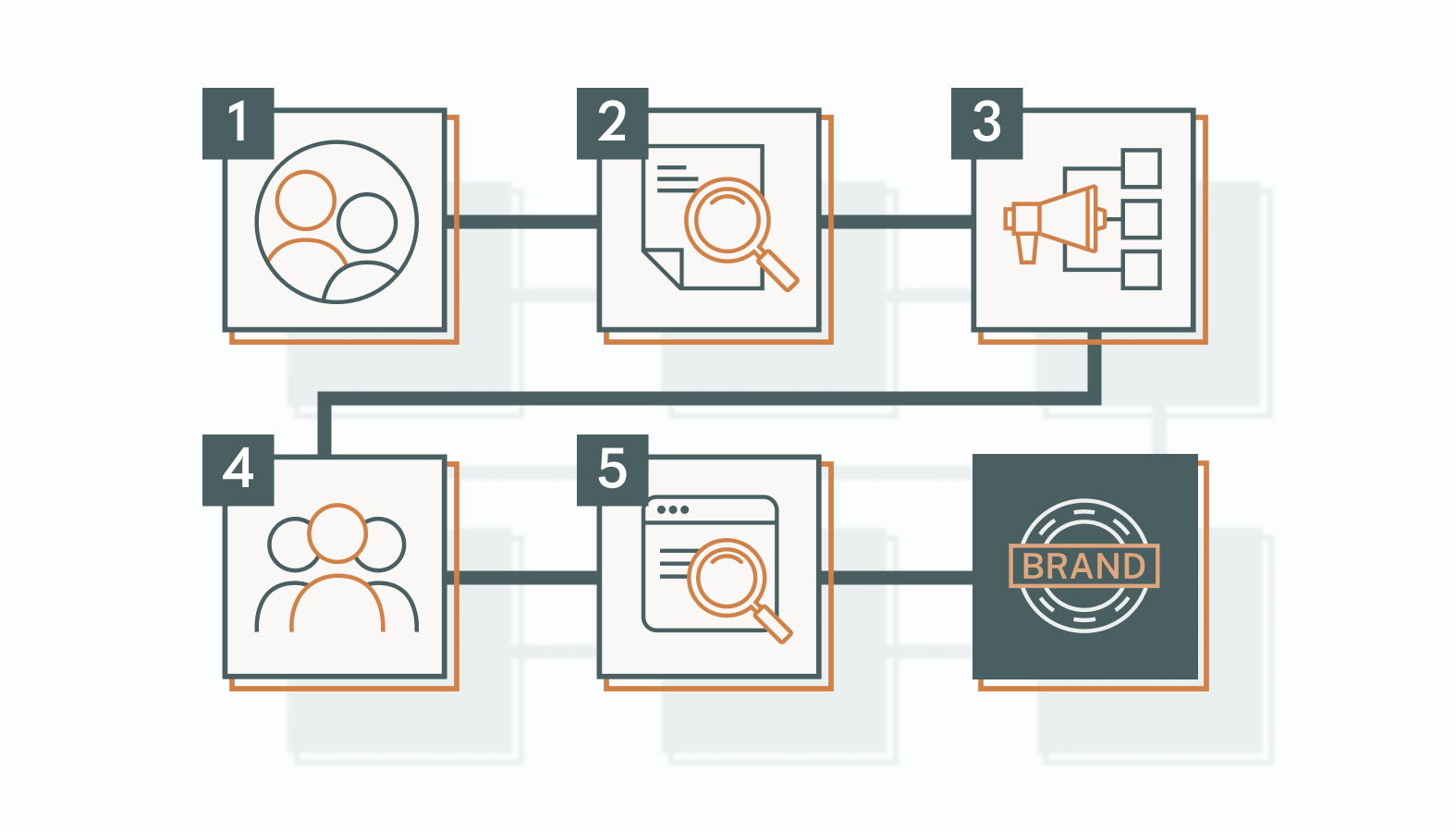In a crowded marketplace, your brand is your company’s handshake – the first impression that sets the tone for everything that follows.
But crafting a brand that sticks isn’t just about a catchy slogan or a cool logo. It’s about developing a strategic roadmap that captures your company’s essence and resonates deeply with your target audience.
Think of it as building a loyal community around your brand’s values and personality. This strategic approach to corporate branding strategy is the secret sauce for achieving long-term success and turning customers into raving fans.
Understanding the Core of Corporate Branding
To unlock the true potential of corporate branding, let’s dive into the core elements and explore the powerful connection between your brand and your image.
Unpacking Corporate Branding
Corporate branding promotes a company’s overall brand name, distinct from specific products or services.
Unlike individual product branding, which targets a single offering, corporate branding encompasses the company’s broader identity and values.
Corporate branding and corporate image are deeply intertwined:
- Branding shapes how stakeholders perceive the company, ultimately molding its corporate image – the external perception of the company.
- A positive corporate image paves the way for a virtuous cycle: customer trust, investor confidence, and employee satisfaction all rise, enhancing the company’s reputation and profitability.
The DNA of a Strong Corporate Identity
So, what makes a brand truly powerful? It all boils down to a solid foundation. Here are the key components:
- Mission & Vision: A strong mission and vision are the GPS for your company’s identity. They give direction (mission) and a destination (vision), keeping everyone focused and motivated. This clarity helps attract talent, guide decision-making, and differentiate your brand.
- Values: These are your company’s moral compass, shaping your company’s culture and decision-making processes. They define how you treat others and the standards you hold dear.
Beyond the core, brand voice, personality, and visual identity enrich your company’s personality traits.
- Brand Voice: It is how you interact with your audience. It should reflect your values and resonate with your target market. Some companies opt for a friendly and approachable voice, while others prefer a sophisticated and authoritative one.
- Personality: This is where your brand becomes a little human. Imagine your brand as a person: what kind of personality would they have? Fun and quirky, or reliable and dependable? This emotional connection can be powerful, and you can become relatable to your audience.
- Visual Identity: This includes the visual elements representing the brand, such as logos, color schemes, typography, and other graphical elements. A strong visual identity makes your brand instantly recognizable across all touchpoints.
By carefully crafting and maintaining these elements, you build a corporate brand that stands out and commands attention.
The Strategic Advantages of Strong Corporate Brands
A great product or service isn’t enough in today’s business world. Brands are battling it out for customer loyalty, and a solid corporate brand is a serious strategic weapon. It sets you apart from the competition, builds trust with your audience, and ultimately boosts your bottom line.
Gaining a Competitive Edge
A distinctive corporate brand can set a company apart, especially in a market saturated with options. Beyond the memorable logo or catchy tagline, branding creates a unique identity that resonates with consumers on a deeper level.
A strong brand captures the essence of your company, making it a no-brainer for them to choose you over the competition.
For instance, consider how Apple’s brand screams innovation, quality, and sleek design. This powerful branding sets them apart from other tech giants, attracting a loyal following willing to pay a premium for its products. Such differentiation is crucial for gaining a competitive edge in any industry.
Consistency as the Foundation of Trust
Consistency in branding is necessary for building brand trust. When a brand consistently delivers promises and maintains a uniform message across all channels, it shows customers it’s reliable. This consistency creates a rock-solid image, making them see you as trustworthy.
Coca-Cola nails this. Their iconic red color and consistent messaging focused on happiness create a dependable, familiar experience for customers around the globe. This unwavering brand identity attracts new customers and retains existing ones, building long-term loyalty.
The Economic Benefits of Cohesive Branding
A cohesive brand identity can lead to significant savings. When your brand is clear and strong, it reduces the need for constant reinvention and squeezes more juice out of your marketing budget.
Imagine having a well-established brand. You can focus campaigns on reinforcing your core values rather than starting from scratch every time. This saves cash and time and enhances brand recall among consumers.
A strong brand can command premium prices (think loyal Rolex fans) and reduce price sensitivity, resulting in better profit margins.
In essence, the strategic advantages of a strong corporate brand extend beyond mere recognition. It sets you apart, builds trust, and saves money – the holy trinity of sustained success in today’s cutthroat market.
The Step-by-Step Blueprint for Corporate Branding Strategy Development
Ready to build a brand that turns heads and earns trust? You need a rock-solid corporate branding strategy – your roadmap to brand fame.
This strategy will help you connect with your audience, keep your message on-point across all channels, and stay flexible as the market evolves.
Setting Your Brand Goals
The foundation of any corporate branding strategy begins with clearly outlining what the brand aims to achieve.
Companies should establish specific, measurable, achievable, relevant, and time-bound (SMART) objectives that guide their branding efforts and keep their team on track.
For example, you might aim to boost brand awareness by 20% in a year or use a revamped loyalty program to increase customer love. Maybe you want social media engagement to explode by 30% in six months.
These focused goals keep you laser-focused and let you track progress so you can adjust your course if needed.
Crafting a Brand Mission, Vision, and Value Proposition
Every great brand has a story to tell, and yours should start with three key ingredients:
- Mission: This is your “why”—your brand’s core purpose. A mission is a concise statement about the company’s existence and what it strives to achieve daily. An excellent example of this is Google’s mission to “organize the world’s information and make it universally accessible and useful.”
- Vision: This is your “where” – the forward-looking statement of the brand that guides your decisions. For example, Tesla’s vision is “to create the most compelling car company of the 21st century by driving the world’s transition to electric vehicles.”
- Value Proposition: This is your “how you win” – the unique reason customers pick you. What makes your brand special? Highlight the unique benefits and value the brand brings to its customers. A compelling value proposition is clear, specific, and something your target audience cares about.
Conducting Comprehensive Target Audience Research
Understanding the target market is essential for crafting a brand that connects deeply with its audience. That’s where deep audience research–demographics, psychographics, and consumer behaviors—comes in.
- Demographics: This provides basic customer information, including age, gender, income, location, education, and occupation.
- Psychographics: This goes deeper and unlocks the real gold. What are their interests? Values? What keeps them up at night? What kind of lifestyle do they aspire to?
- Consumer Behaviors: Then, there’s how they behave as consumers. What catches their eye? How do they make decisions about what to buy? Are they brand loyal or always chasing the next big thing?
Tools like surveys, focus groups, and analytics software can provide valuable insights into the preferences and needs of the target audience.
Understanding your target market on this deeper level allows you to tailor your brand message and image to resonate authentically with them.
Establishing a Unique Brand Voice
Imagine your brand as a person at a party. How would they chat with different people? That’s the idea behind the brand voice. It’s your consistent way of talking across all platforms, but it can bend slightly depending on the situation.
For example, a tech company might adopt an innovative and friendly voice, while a financial institution might prefer a more authoritative and trustworthy tone.
The key is to keep your voice consistent, reflecting your brand’s personality and values. Building a strong brand identity requires you to speak your truth but adapt your style to fit the conversation.
Talking to the Tribe: Crafting Your Key Messages
A compelling brand story is just the first step – knowing who hears it makes all the difference.
Effective marketers craft key brand messages to communicate to different groups, like customers, investors, and even your own team.
Here’s the trick: keep it short, sweet, and sticky. Your messages should be easily remembered and aligned with your brand’s core mission and values. Think about it:
- Customers: How can your product make their lives easier? Maybe it’s “We simplify your day” or “Effortless living starts here.”
- Investors: What’s your company’s growth plan? Maybe it’s “Sustainable growth, powered by innovation” or “Investing in a brighter future.”
- Employees: What kind of work environment do you offer? Maybe it’s “Join us in making a difference” or “Be part of something bigger.”
Tailoring these messages to each audience ensures everyone understands and appreciates your brand’s core values and promises. It’s all about speaking the right language to the correct people.
Managing Online Reputation
Maintaining a brand’s online reputation is more critical than ever.
Someone in your team must be responsible for proactively managing social media so that your company can:
- Monitor: Use tools like Google Alerts and social listening platforms to listen to what people say about your brand online.
- Engage: Respond to customer questions and comments quickly. Show them the brand values their opinions and feedback—it goes a long way.
- Address Negative Feedback: All businesses get some unhappy folks, too. The key is to handle complaints honestly and professionally, turning a potentially harmful situation into a chance to show how much you care about customer satisfaction.
The Role of Employer Branding in Attracting Top Talent
When a company works on its branding, it captures awesome customers and attracts rockstar employees.
Employer branding tells the world what kind of place you are to work for, including your culture, values, and all the perks employment brings.
For example, Google and Netflix are known for their exceptional workplace cultures, which snag the best talent and make their overall brand even more robust. So, how do you build a killer employer brand?
Here are some ideas:
- Show, Don’t Tell: Let your employees rave about you! Share testimonials and showcase your company culture.
- Sweeten the Deal: Offer competitive benefits and perks that make working for you a no-brainer.
- Make Work Fun: Promote a positive work environment where people feel valued and engaged.
Building a strong employer brand alongside your overall branding strategy is a win-win. You create a cohesive identity that resonates with everyone you need for success – both customers and future all-stars on your team.
Case Studies of Successful Corporate Branding
The following real-life examples show how different corporate branding strategies can take companies to the next level and even become industry leaders.
Case Study: Apple’s Brand Ecosystem
Apple is known for its sleek gadgets and futuristic tech, but what makes regular customers into die-hard Apple fans is the company’s whole brand ecosystem – everything works together seamlessly.
Apple keeps it simple and elegant, focusing on the ultimate user experience. The company’s mission—“to bring the best user experience to customers through innovative hardware, software, and services”—is evident in every product they release.
Apple reinforces its brand promise through consistent branding elements, such as minimalist designs, super user-friendly interfaces, and premium materials that scream quality (and justify that price tag).
This consistent brand message across everything they do – from product design to marketing – has a powerful effect. People see Apple as innovative, reliable, and cool. It’s an emotional connection that keeps customers coming back for more. Plus, everything works together flawlessly – iPhone, iOS, iCloud, you name it. Once you’re in the Apple world, it’s easy to stay there.
Alphabet’s Corporate Branding Approach
Google’s parent company, Alphabet, does branding a little differently. They use a “house of brands” approach, which means they keep Google as their own thing while letting other ventures like Waymo (self-driving cars) shine under their own names, all under the Alphabet umbrella.
Alphabet’s brilliant strategy allows them to manage multiple businesses without muddying the waters. Google stays squeaky clean, while riskier ventures can experiment without dragging down the whole company.
Think of it this way: each brand has its own mission and goals, but they all contribute to Alphabet’s big-picture mission of organizing the world’s information. This structure lets them innovate like crazy without hurting Google’s trusted brand.
It also means they can allocate resources and manage risk more effectively because each business operates independently but still gets the support of Alphabet when needed.
Nestlé’s Global Corporate Image
Nestlé, the food and beverage giant, has mastered the art of balancing a strong brand image with a massive product portfolio. Its focus is on nutrition, health, and wellness, a message that resonates with people all over the world.
Nestlé’s brand identity (its commitment to good food and good living) acts like a stamp of approval for all its individual products. Its “Good Food, Good Life” mission is woven into everything it does, from packaging design to marketing campaigns.
Plus, their logo and iconic colors ensure instant brand recognition no matter where you are in the world.
To maintain a consistent global corporate image, Nestlé uses centralized control over its core brand identity but decentralized control over individual product lines. This lets Nestlé tailor products to local preferences and regulations while maintaining that recognizable Nestlé feel.
Nestle’s dual strategy is genius. They’ve become a brand that feels familiar yet local, building trust and loyalty with consumers everywhere.
Implementing Your Corporate Branding Strategy
The key to successful branding is putting your strategy into action. Here’s how to get started:
Assembling a Brand Strategy Team
So you’ve got your killer brand strategy; Now it’s time to implement it.
You can’t do it alone. Realizing your brand vision would take a village, so start assembling your brand dream team.
This cross-functional team should include the best-of-the-best from various departments, such as senior leadership, marketing, communications, product development, and even HR.
Having a diverse team means each person brings a different perspective and expertise to tackle all kinds of challenges.
This collaboration also gets everyone invested in the success of the brand strategy, making it way more likely to stick. It also results in a more well-rounded brand.
Establishing Brand Guidelines and Voice
With your dream team assembled, it’s time to craft brand guidelines that will ensure a consistent and cohesive brand message across all communications.
These guidelines outline the visual and verbal elements of the brand, including logos, color schemes, typography, imagery, and even the way you talk (your brand voice).
Clear guidelines serve as rules of engagement for your brand, ensuring your corporate identity stays strong and recognizable no matter where someone encounters it.
Inconsistent messaging waters down your brand and confuses people.
As such, you must also focus on building a well-defined brand voice that reflects your personality and values. A consistent voice across all your communications makes a powerful impact and helps people connect with your brand on a deeper level.
Marketing Channel Analysis for Brand Messaging
With your brand story locked in tight, you must choose the proper marketing channels where the target audience is most active and receptive. This can be on social media platforms, email newsletters, search engines, or traditional media.
For example, a company selling to other businesses (B2B) might succeed on LinkedIn or industry forums, where decision-makers lurk. However, a brand targeting younger folks (B2C) might crush it on Instagram or TikTok.
Your decision relies on understanding your audience’s habits and what makes them tick. Once you know that, you can tailor your message and pick the best channels for maximum engagement and reach.
Employee Advocacy and Brand Representation
Employees play a pivotal role in embodying and advocating for the corporate brand. Get them on board with your branding – your employees are the best ambassadors for influencing public perception.
Everyone, from the CEO to the intern, must clearly understand your brand’s values, mission, and vision. Encourage them to share positive experiences and spread the brand love on social media.
Consider conducting regular training sessions, encouraging clear internal communication, and building a company culture that reflects your brand.
When your employees truly believe in what you do and live it out, their advocacy becomes a super-powerful tool for building brand loyalty and recognition.
Monitoring and Adaptation
The implementation phase doesn’t end with the launch of branding initiatives. It’s just the beginning; the real test is staying on top of things.
For your brand to remain relevant, you must constantly monitor your brand’s performance and be ready to adapt.
To measure your brand’s performance, set key performance indicators (KPIs) or metrics that track your progress towards your goals. KPIs could include brand awareness, customer engagement, market share, or what people say about you online (sentiment analysis).
Regularly checking these metrics allows companies to identify areas of improvement and adjust their strategies accordingly.
With the market, what customers want, and even your competition constantly evolving, your company must also be flexible and responsive to the changes. It ensures your branding efforts remain effective with the right people and keep your brand fresh.
Solidifying a Corporate Brand Legacy
Crafting a powerful corporate brand is no small feat. It requires a strategic plan, consistent execution, and ongoing attention.
But once you’ve mastered corporate branding strategies, a strong brand becomes a recognizable and trusted asset that stands the test of time.
This guide equipped you with the knowledge and examples you need to achieve branding excellence. Consider it your roadmap to success.
Ready to embark on your brand journey? Here’s how to get started:
- Take Stock: Evaluate your current brand and identify areas for improvement.
- Strategize: Implement the actionable strategies discussed in this guide.
- Build Your Legacy: By taking these steps, you’ll be well on your way to solidifying a brand that resonates with your audience and fuels long-term success.
Building a Brand that Lasts: Expert Help When You Need It
Building a lasting brand requires dedication, but the rewards are substantial! This guide equips you with valuable tools for success. However, creating a brand can be time-consuming. Sometimes, you just want to launch and see results quickly.
That’s where we come in. Our expert team brings strategic thinking and consistent execution to maximize your brand’s impact. We can partner with you to hit the ground running with a cohesive strategy.
Whether you’re a startup or looking to refine your existing brand, our goal is to create a brand that resonates deeply with your audience. We understand every business is unique, and a personalized approach is key.
If you have questions or want to see how a tailored branding strategy can benefit you, let’s chat!
Schedule a candid conversation with one of our brand experts ». It’s a no-pressure discussion to gain valuable insights and make informed decisions. Let’s discuss your branding goals and challenges – we’re here to support your journey every step of the way.









